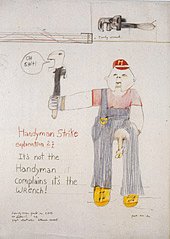Strange Messenger
dal 19/12/2003 al 29/2/2004
Segnalato da
19/12/2003
Strange Messenger
Haus der Kunst, Munich
The Work of Patti Smith presents more than 100 works on paper, including a new series of large-scale drawings. In addition, original manuscripts, recent photographs and the video clip, Summer Cannibals, by the photographer Robert Frank will be on view.

The Work of Patti Smith
Curated by John Smith of The Andy Warhol Museum. One of the four Carnegie Museums of Pittsburgh
In the exhibition Strange Messenger: The Work of Patti Smith the artist, born in 1946 in Chicago, presents her drawings, which she has been producing, along with her poems, since the early 1960’s.
Strange Messenger: The Work of Patti Smith presents more than 100 works on paper, including a new series of large-scale drawings. In addition, original manuscripts, recent photographs and the video clip, Summer Cannibals, by the photographer Robert Frank will be on view. Smith’s latest series of large-scale drawings was inspired by her reaction to the terrorist attacks on September 11, 2001. A newspaper photograph of the destruction of the towers of the World Trade Center reminded her of Peter Brueghel’s The Tower of Babel (1563) and provided the starting point for these drawings. In her book of poems Babel, published in 1978, she had already dealt with this biblical story, a description of man’s hubris. In her drawings Smith frequently combines pictures and words to form an impressive pictorial script and weaves together passages from the peace gospel of the Essenes, the Koran and other sources and allows the letters to dissolve into her drawings.
Although Smith became famous mainly for her music and poetry, her drawings were already in many museums, including the Museum of Modern Art in New York, among others. As early as the end of the 1960’s, Smith’s close friend, the photographer Robert Mapplethorpe, encouraged the artist to start drawing – even before she had devoted herself to writing and composing. What is special about her drawings, which are inspired by William Blake and Antonin Artaud among others, is the thin, hard line and the soft coloring. Smith uses a thin, delicate stroke, but one that at the same time is so sharp that it seems to injure the figures. She frequently incorporates extracts from her own poems or from other authors in her drawings and compares the act of artistic creation with a catharsis.
Smith’s debut album Horses came out in 1975. Produced by John Cale, it made Smith a wellknown rock poet. The album Easter made her world-famous. By the late 1970’s Smith had reached the pinnacle of her fame. In 1979 she ended her career temporarily with the record Wave and moved from New York to Detroit. Almost ten years later, Smith celebrated her comeback with Dream of Life, which she recorded together with her husband Fred Smith. Since then she has released numerous albums, in which she combines garage rock with political poetry. A ‘best of’ compilation Land (1975-2002) was release in March 2002.
The exhibition will be complemented by a homage to the artist in the form of works by the fashion designer Ann Demeulemeester. Inspired by the Smith’s book Woolgathering, garments of tulle, on which excerpts from Smith’s texts were inscribed in glass beads on colon ribbons, were created for the designer’s summer collection 2000. The original photographs used as the ‘models’ for the well-known Smith portraits by Franz Gertsch and Dan Graham’s video documentation Rock My Religion are also on view. One of the aims of the exhibition is to reflect the various sides of the vibrant and eccentric personality of the artist Smith and to illuminate her work from different vantage points.
The exhibition is in cooperation with The Andy Warhol Museum. One of the four Carnegie Museums of Pittsburgh.
Image:
Patti Smith, Handyman Strike, 1968
© Patti Smith
The Andy Warhol Museum has produced a catalogue entitled Strange Messenger: The Work of Patti Smith to accompany the exhibition. It contains essays and color reproductions of the artist’s works and will be on sale at the Haus der Kunst during the exhibition.
Haus der Kunst
Prinzregentenstraße 1, 80538 München
Telefon 089 / 21 127- 0 oder 21 127- 113
Fax 089/ 21 127-157



